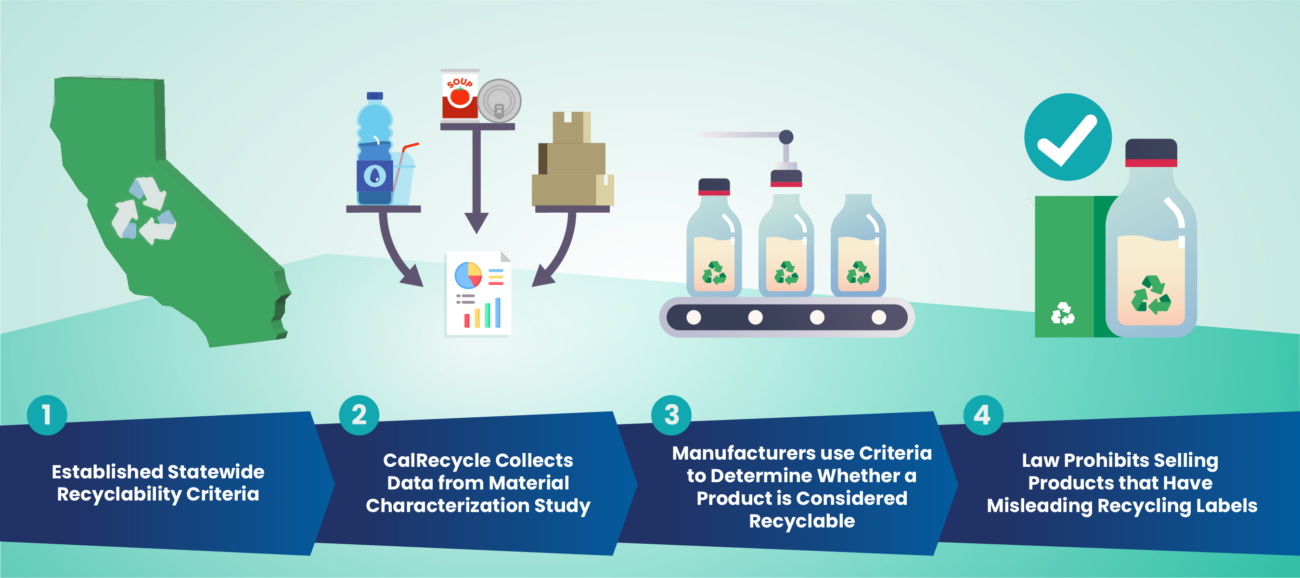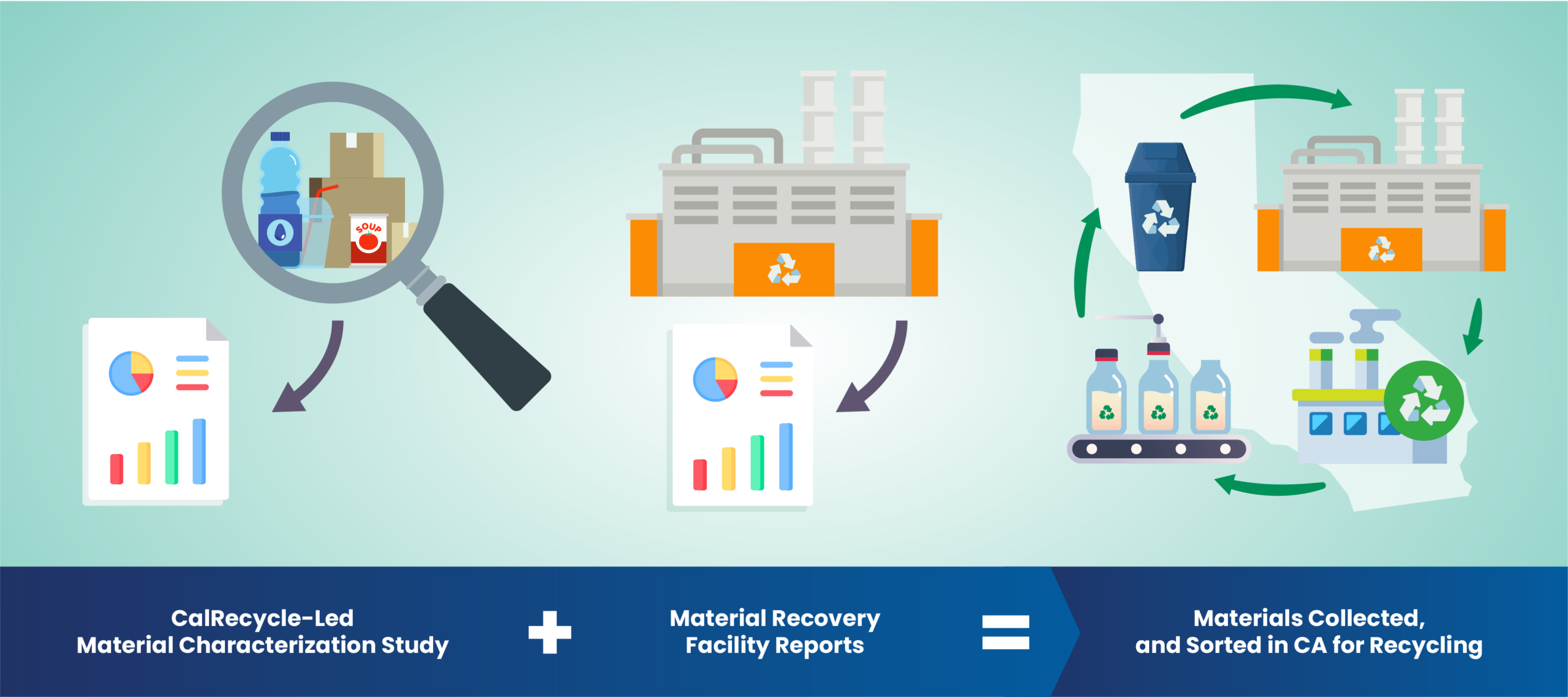Accurate Recycling Labels
Many Californians rely on products’ chasing arrows symbol to tell if it’s recyclable. Until 2021, California did not set specific criteria to use chasing arrows recycling logo.
Lawmakers enacted SB 343 (Allen, Chapter 507, Statues of 2021), which prohibits use of the chasing arrows or any other indicator of recyclability on products and packaging unless certain criteria are met.
Increasing recycling in California first requires accurate labels on recyclables.
Labeling restrictions established by SB 343 apply to products and packaging manufactured after October 4, 2026 (18 months after publication of the Final Findings Report). Products and packaging manufactured before that date are not subject to the restrictions, regardless of when they are sold.
Identifies What Gets Recycled
SB 343 directs CalRecycle to publish data about the types of materials actually recycled in California. Manufacturers and other interested parties must use that information as part of their assessment of whether products can be considered recyclable for labeling purposes. The law outlaws manufacturers and others from selling products or packaging labeled as recyclable unless the items are regularly collected and processed for recycling in the state. SB 343 neither authorizes nor directs CalRecycle to determine or report on the recyclability of particular products and packaging or the appropriate use of the chasing arrows or other indicators of recyclability. Parties evaluating whether a product is eligible to be labeled recyclable in California may utilize additional information not published by CalRecycle.
This will:
- Help vendors and consumers make informed decisions about products
- Provide an objective basis for holding manufacturers, distributors, and retailers responsible for misleading consumers about whether products get recycled
Program News
- CalRecycle published SB 343 FAQ on August 13, 2025.
- CalRecycle published an update to Table 2 of the SB 343 Final Findings Report on August 8, 2025 (Update Letter and Attachment 1). CalRecycle does not anticipate publishing a new version of the complete report until the required update in 2027.
- CalRecycle published the SB 343 Material Characterization Study Final Findings – 2023/2024 on April 4, 2025.

Steps to Identify What’s Recyclable
Often referred to by industry stakeholders as the “Truth in Recycling” or “Truth in Labeling” law, SB 343 required CalRecycle to complete two major steps by January 1, 2024.

Step 1. Study of What Gets Recycled (Material Characterization Studies)
- CalRecycle commissioned a statewide analysis at materials recovery facilities in 2023 and 2024 to identify which materials are commonly collected, sorted, sold, or transferred for recycling in California.
- CalRecycle awarded the contract for the 2023 Material Recovery Facility (MRF) Recyclable Material Study to Cascadia Consulting Group.
- CalRecycle published the SB 343 Material Characterization Study Final Findings – 2023/2024 (DRRR-2025-1750) on April 4, 2025.
- CalRecycle published an update to Table 2 of the SB 343 Final Findings Report on August 8, 2025 (Update Letter and Attachment 1).
- The law requires CalRecycle to revise the study in 2027 and every five years after that. CalRecycle will continuously improve its methodology and approach to support a broad look at recyclability of materials across the state.
- Future studies will be designed to better align with covered material categories for SB 54 (Allen, 2022).
Step 2. New Reporting Requirements
CalRecycle updated regulations to require material management facilities and operations to report regularly through CalRecycle’s Recycling and Disposal Reporting System:
- How materials are collected or processed in the state
- Which material types and forms facilities recover and don’t consider contaminants
This new reporting will commence in 2025.
Implementation
of SB 343
2021
- Gov. Newsom signed SB 343 Into law
2022
- Developed methodology for study
- Request for proposals for material characterization study
2023
- Material characterization study contract awarded
- Contractor conducted fieldwork
- CalRecycle published preliminary findings on December 28, 2023
2024
- The recycling and disposal reporting regulations updated to require additional MRF reporting
- Public comments on preliminary findings received – February informational session
- Contractor conducted additional fieldwork
- CalRecycle conducting additional data collection on jurisdiction recycling programs
- CalRecycle published revised preliminary findings on December 31, 2024
2025
- CalRecycle hosted a public meeting on February 3, 2025
- Public comments on revised preliminary findings received
- CalRecycle published the SB 343 Material Characterization Study Final Findings – 2023/2024 on April 4, 2025
2026
- Recyclability criteria apply to products and packaging manufactured after the 18-month period following publication of the final findings report
2027
- Conduct and publish second material characterization study
2032
- Publish additional findings every 5 years
Provides Information to Clarify Mislabeling
Although existing laws make it illegal to use deceptive labels on products, little credible information was available to define accurate and deceptive recycling labels.
SB 343 directs CalRecycle to:
- Research what is collected and processed for recycling in California and
- Publish this information so manufacturers can accurately label products that get recycled.
Local Jurisdictions and the California Attorney General may also use this information when filing civil suits and charging monetary penalties against companies who are not labeling their products accurately. Deceptive labeling is also subject to civil suits pursuant to the Business and Professions Code.
After CalRecycle publishes each new study, manufacturers will have 18 months to ensure the updated information supports the use of the chasing arrows recycling symbol on their products.
For More Information
- For updates about SB 343 Material Characterization Study progress, subscribe to the Material Characterization Study Listserv.
- For SB 343 frequently asked questions, visit SB 343 FAQ.
- For more information on updates to the reporting requirements for materials management facilities and operations, visit the CalRecycle Recycling and Disposal Reporting System Regulations page.
Contact
For non-media inquiries about the program to WasteChar@calrecycle.ca.gov.
For media inquiries OPA@calrecycle.ca.gov.
